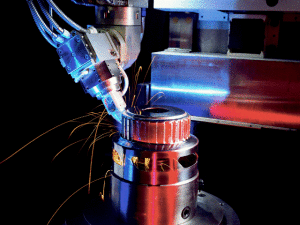 Laser cutting machines represent important manufacturing tools that are critical to the production of a range of manufactured parts and finished goods, with primary usage in production processes to shape, cut, bore, weld, grind, drill, tap, and form metal components. These machines score over conventional cutting machines in terms of precision, flexibility, and accuracy. Rapid economic development, industrialization, expansion in manufacturing bases, and massive investments in machinery were largely responsible for the market’s strong evolution over the years.
Laser cutting machines represent important manufacturing tools that are critical to the production of a range of manufactured parts and finished goods, with primary usage in production processes to shape, cut, bore, weld, grind, drill, tap, and form metal components. These machines score over conventional cutting machines in terms of precision, flexibility, and accuracy. Rapid economic development, industrialization, expansion in manufacturing bases, and massive investments in machinery were largely responsible for the market’s strong evolution over the years.
With growth strongly linked to the health of end-use industries, the world economic recession weakened sales of laser cutting machines during 2008 and 2009 before posting a recovery in the year 2010. The recovery was largely aided by the resurgence of growth fundamentals in end-use sectors such as aerospace and automobile manufacturing, medical devices, renewable energy, semiconductors, and consumer electronics. Current growth is driven by steady gains in global GDP performance and improving industrial and manufacturing activity, as indicated by the relatively stable global manufacturing Purchasing Managers Index (PMI).
The research report titled “Laser Cutting Machines: A Global Strategic Business Report”, announced by Global Industry Analysts, provides a comprehensive review of market trends, growth drivers, regulations, issues, challenges, mergers, acquisitions, and other strategic industry activities of major players worldwide.
Future growth will be spearheaded by the consumer electronics sector, supported by spiraling demand for smartphones and tablet PCs. Laser cutting machines are increasingly used for the production of integrated circuits, displays, and printed circuit boards (PCBs). The strong automotive industry in developing countries is also expected to aid market growth. Novel application of laser cutting machines in the aerospace and defense sector represents another important growth driver. The sector largely depends upon precision laser cutting for manufacturing highly advanced parts and components with complex geometric designs. Growth in commercial aviation, rising global air traffic which is set to explode further in the coming years, strong military budgets against a backdrop of rising terrorism, and the need for efficient homeland protection bodes well for high-end laser machines used in the aerospace and defense sector.
Growing focus on plant automation in most end-use markets in a bid to enhance productivity, reduce downtime, and conserve energy is poised to benefit demand for robotic laser cutting machines. A key technology innovation expected to benefit the market in the near term is the development of ultrashort or ultrafast pulsed lasers, which are gaining rapid traction in material processing applications due to their ability to process majority of material types with high precision.
As stated by a new market research report on laser cutting machines, Asia-Pacific represents the largest market worldwide. The region also represents the fastest growing market, with a CAGR of 11.1 percent over the analysis period. Strengthening GDP, increasing industrialization, expanding manufacturing base, along with rapidly growing electronics, semiconductor, and automotive end-use industries, represent key growth drivers in the region.
The report “Laser Cutting Machines: A Global Strategic Business Report” provides market estimates and projections in dollars for all major geographic markets, including the United States, Canada, Japan, Europe, Asia-Pacific, the Middle East & Africa, and Latin America.



